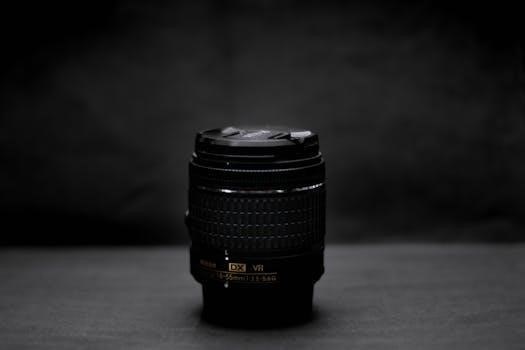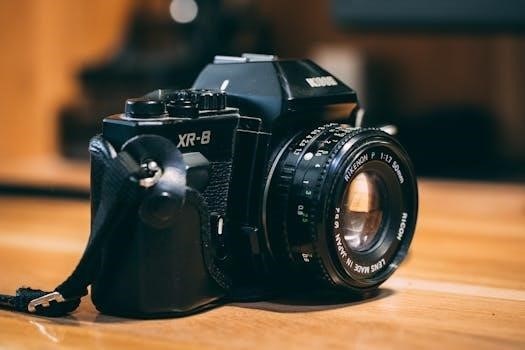Nikon N80 User Manual⁚ A Comprehensive Guide
Welcome to a comprehensive guide for the Nikon N80! This manual provides essential information, including how to download, key features, speedlight usage, manual mode, troubleshooting, and lens compatibility․ Learn about film rewinding, variations, and maintenance for your N80/N80QD camera․ This guide is a must-have for new and experienced users!
The Nikon N80, also known as the F80 outside of the U․S․, represents a significant step in film camera technology, offering a blend of user-friendly features and advanced capabilities․ Released in January 2000, this prosumer SLR camera was designed to appeal to both beginners and experienced photographers․ The N80/N80QD is a versatile camera with a built-in Speedlight, making it easy to capture images in various lighting conditions․ The “QD” designation indicates the inclusion of a Quartz Data back, enabling imprinting of date and time information onto the film․ It stands out for its reliable performance and the ability to use a wide array of Nikkor lenses․ This introduction will guide you through the basic features, setting the stage for a comprehensive understanding of the N80/N80QD camera․ Be sure to familiarize yourself with the camera and keep the manual handy as you explore it’s many capabilities․
Downloading the Nikon N80 User Manual
Accessing the Nikon N80 user manual is essential for fully understanding your camera’s capabilities․ Several online resources offer downloadable PDF versions of the manual, ensuring you have all the necessary information at your fingertips․ These manuals, often available for free, provide detailed instructions and diagrams to guide you through every function of the N80/N80QD․ To download, simply search online for “Nikon N80 user manual PDF”․ Look for reputable sites that specialize in camera manuals, such as cameramanuals․org or manuals․lib․ These sites typically host complete, high-quality scans of the original Nikon documentation․ Remember to save the manual to your device for easy access whenever you need assistance; Having a digital copy ensures you can consult it regardless of your location, enhancing your photography experience with the N80/N80QD․

Key Features of the Nikon N80
The Nikon N80 boasts several key features that make it a versatile camera for both beginners and enthusiasts․ Its built-in Speedlight, or flash, provides convenient lighting for various shooting conditions․ The camera’s vertically travelling, focal plane shutter offers a wide range of speeds, from 1/4000 s to 30 s, and bulb mode for long exposures․ The N80 also incorporates 3D Matrix Metering when using D- or G-type Nikkor lenses, enhancing exposure accuracy by factoring in distance information․ Additionally, it supports various shooting modes, including manual mode for complete control over aperture and shutter speed․ The N80 is known for its user-friendly design, making it accessible for those new to SLR photography․ Its robust construction ensures durability, and it offers a comfortable grip for extended shooting sessions․ Overall, the N80 combines ease of use with advanced features, making it a valuable tool for capturing memorable moments․
Understanding the N80’s Speedlight
The Nikon N80 features a built-in Speedlight, which is Nikon’s term for a flash unit, designed to provide additional light for your photographs․ This integrated flash is particularly useful in low-light situations or when you need to fill shadows in bright sunlight․ The Speedlight is easy to use, and it automatically pops up when needed in certain shooting modes․ It’s a convenient tool for both beginners and experienced photographers․ The Speedlight offers various modes, including automatic flash and red-eye reduction․ Understanding how to utilize the Speedlight effectively is essential for getting well-lit images․ It’s important to be aware of the flash’s range and how it interacts with different subjects and distances․ The Speedlight is a simple yet valuable feature that enhances the N80’s versatility, allowing users to capture great shots in diverse lighting conditions․ It helps ensure your photos are bright and clear, adding another dimension to your photographic experience․ Mastering the flash is key to unlocking the full potential of the N80․
Using Manual Mode on the Nikon N80
Manual Mode on the Nikon N80 provides complete control over your camera’s settings, allowing you to adjust both the shutter speed and aperture according to your creative vision․ To switch to Manual Mode, you’ll need to locate the mode dial or button and select ‘M’․ Once in Manual Mode, you can independently set the shutter speed, which controls how long the camera’s shutter remains open, and the aperture, which determines the size of the lens opening․ Experimenting with these settings can help you achieve the desired depth of field and motion blur effects․ This mode is perfect for situations where you want to override the camera’s automatic calculations and take full artistic control of your images․ It’s a great way to learn the relationship between these two important camera settings and their effect on your final photograph․ Understanding and mastering manual mode opens a world of creative possibilities, allowing you to capture unique and personalized images with your Nikon N80․ It’s a journey worth exploring for any dedicated photographer․
Troubleshooting Common Issues⁚ “Err” Message
Encountering an “Err” message on your Nikon N80 can be frustrating, but it often signals a simple issue․ This error message typically indicates a problem with the camera’s connection to the lens․ Start by detaching the lens and carefully inspecting the electronic contacts on both the lens and camera body․ If you notice any dirt or grime, gently wipe them clean with a soft, dry cloth․ Reattach the lens securely, ensuring it clicks into place․ If the error persists, it could mean that the lens and camera aren’t properly communicating․ In some cases, the error may signal an internal malfunction, especially if cleaning the contacts doesn’t resolve the problem․ Other users have mentioned that this issue can lead to the camera refusing to operate․ If you find that your N80 continues to display the error message after trying these fixes, it is advisable to seek professional assistance for repair․ Don’t panic, it’s often a fixable problem․

Lens Compatibility and 3D Matrix Metering
The Nikon N80 is designed to work seamlessly with a variety of Nikkor lenses, particularly D-type and G-type lenses․ This compatibility allows the N80 to utilize its advanced 3D Matrix Metering system effectively․ This sophisticated metering system doesn’t just measure light; it also incorporates distance information from the lens to determine the most accurate exposure settings․ This feature helps ensure that your images are well-exposed, even in challenging lighting conditions․ When using compatible lenses, the camera will automatically consider the distance between the lens and subject, alongside the light intensity, to calculate the optimal aperture and shutter speed․ This process enhances the overall image quality and minimizes the need for manual adjustments․ This advanced metering helps the N80 produce consistently excellent results․ For optimal performance, always ensure that the lens is securely attached and that the contacts are clean for best results with the 3D Matrix Metering system․ Using non-compatible lenses might impact the accuracy of the metering system․

Film Rewinding Instructions for the Nikon N80
Rewinding film on the Nikon N80 is a straightforward process, but it’s crucial to do it correctly to avoid damaging your film․ Unlike some cameras, the N80 doesn’t have a dedicated rewind button․ Instead, the camera automatically begins the rewind process when the roll of film reaches its end․ You’ll notice the camera stop advancing film and the film counter will display “end”․ To start the rewind, ensure the camera is powered on․ The N80 will then automatically rewind the film back into the canister․ You’ll hear the motor engaging as it winds the film․ Once the rewinding is complete, the camera will stop and the film counter will reset․ You can now safely open the film door and remove the film canister․ Avoid forcing the film door open before the rewind is finished․ If the film does not automatically rewind, consult the manual for further troubleshooting․ Always be patient during the rewind process and avoid using excessive force, as this may damage the camera’s internal mechanisms․

Nikon N80 Variations⁚ N80QD and F80
The Nikon N80 camera has a few variations, primarily the N80QD and its international counterpart, the F80․ The N80QD, often referred to as the “Quartz Date” version, includes a feature that allows users to imprint the date and time directly onto their photographs․ This is a notable distinction from the base N80 model․ The F80 is essentially the same camera as the N80, but it is the model name used in markets outside of North America․ While the core functionality of the N80, N80QD, and F80 remains consistent, the presence of the quartz date function in the N80QD is a key differentiating factor․ Additionally, some minor regional variations in labeling or packaging might exist․ It’s crucial to remember that the user manuals for these models are largely interchangeable, with the exception of the date imprinting feature instructions․ Both the N80 and F80 boast a built-in Speedlight and hot shoe, while lacking a mirror lock-up function․ The shutter speeds range from 1/4000 s to 30 s, and bulb․
Maintenance and Repair⁚ Battery and Door Film
Maintaining your Nikon N80 involves some key areas, including battery replacement and addressing issues with the door film․ The N80 requires batteries for operation, and a common maintenance task is changing these when they are depleted․ Ensure you use the correct type of batteries as specified in the manual to avoid any operational issues․ The film door, crucial for protecting the film, can sometimes develop issues with its light seals․ If you notice light leaks or the door not closing properly, replacing the door film or light seals might be necessary․ This can often be done with a DIY approach, using a detailed guide with instructions․ However, for more complex issues, seeking professional repair is advisable․ Regular inspection of the battery contacts and the film door can prevent many common problems․ Proper care and timely maintenance will ensure the longevity and reliable performance of your N80 camera․
